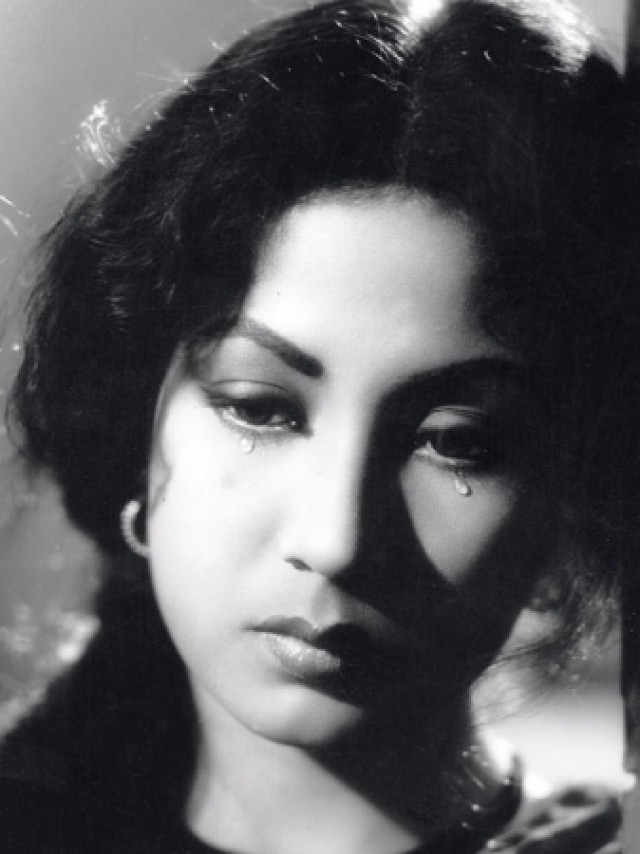

Bol Mere Maalik
Film: Halaku
Year: 1955
Music: Shankar Jaikishan
Lyrics: Hasrat Jaipuri
A scene from Halaku (1955). The lead actress (Meena Kumari), with a group of other ladies, bound in ropes, in a palm-tree-laden oasis within a desert. The distraught lady questions the Almighty about the veracity of His verdict.
bol mere maalik tera kya yahin hai insaaf
jo karte hain laakh sitam unko tu karta maaf
bol mere maalik tera kya yahin hai insaaf…
(Tell me o Lord whether this is your justice
That you would just pardon those committing myriad crimes!)
It is human tendency to let emotions overcome our senses when questioning the Judge. Arguments are best put forward when one articulates them rationally without betraying melodramatic emotions. However, humans as we are, one cannot help but stifle a sob or reveal a ‘choke of the voice’ while doing so.
This kind of muted yet assertive emoting was right up Lata Mangeshkar’s alley. As I have mentioned elsewhere, her tonal quality paints an image of a quintessentially petite and coy lady and yet, her enunciation, diction and general way of singing has *assertion* written all over it… something that one identifies with the ‘pucca’ classical singers of our subcontinent. This delightful dichotomy is what, in my opinion, makes Lata Mangeshkar the immensely successful singer that she was (during her heydays, which spanned across at least two and a half decades) and Bol Mere Maalik is one shining example of that trait.
After an elaborate 90-second prelude (a situational requirement in the movie), Lata starts off on a high pitch, beseeching the Almighty. Once the rhythm starts, the line ‘bol mere maalik…’ is repeated thrice… Twice, around the ‘Sa’ of the higher octave. Then, when the line is sung for the third time, the notes descend to the main tonic (‘Sa’) of the song. The protest is made in a raised voice, and the emotional deluge is indicated by the scaling down of the notes, thereafter.
It is here that Lata has resisted the temptation of slipping in a melodramatic quiver of her voice, or a sob, to convey this. All that she does is to constrict her articulation of the word ‘insaaf’ for a small instant to convey ‘choking with emotion’. This is executed so subtly and beautifully, that one can only marvel at the intellectual refinement that she brought in her singing, despite the situational temptation of ‘over-emoting’.
She does it on two more occasions, during the two ‘antara’-s: first in ‘daaman mere habeeb ka haathon se chhut gaya’.. (on the word ‘gaya’) and later in ‘apni zubaan pe naam bhi teraa naa laayenge’… (on the word ‘laayenge’)
A memorable song from a memorable soundtrack. Shankar Jaikishen, in the epicenter of their purple patch, used their Midas touch to craft this song on the soulful words of Hasrat Jaipuri. And, in typical ‘SJ style’ they have internalized the phrases of raag Madhuwanti to leave their indelible stamp of class on this song. Raag Madhuwanti’s introspective nature has mostly manifested itself in slow and contemplative songs like ‘rasm-e-ulfat ko nibhaaye to nibhaaye kaise’ (‘Dil Ki Raahein’ – 1973 – Madan Mohan) or ‘chukchukali paal ek’ (Marathi Non Film – 1968 – Shrinivas Khale) or ‘badalti nabhaache rang’ (Marathi – ‘Ye Re Maajhya Maangalya’ – 1955 – Vasant Desai).
Shankar Jaikishan’s glorious use of cellos accentuates the raag and also gives a ‘symphonic’ feel to the orchestration. Then the chorus, hums in a subdued manner to lend a magical touch to this song. Fusion of music at its very best.
I cannot help but feel that Hridaynath Mangeshkar’s use of the humming chorus for the Madhuwanti-based song of Lata Mangeshkar, ‘ko birahini ko dukh jaane ho…’ (Non Film – ‘Chala Wahi Des’ – 1973) is almost like a tribute to this magnificent composing duo.
Author info is not available!